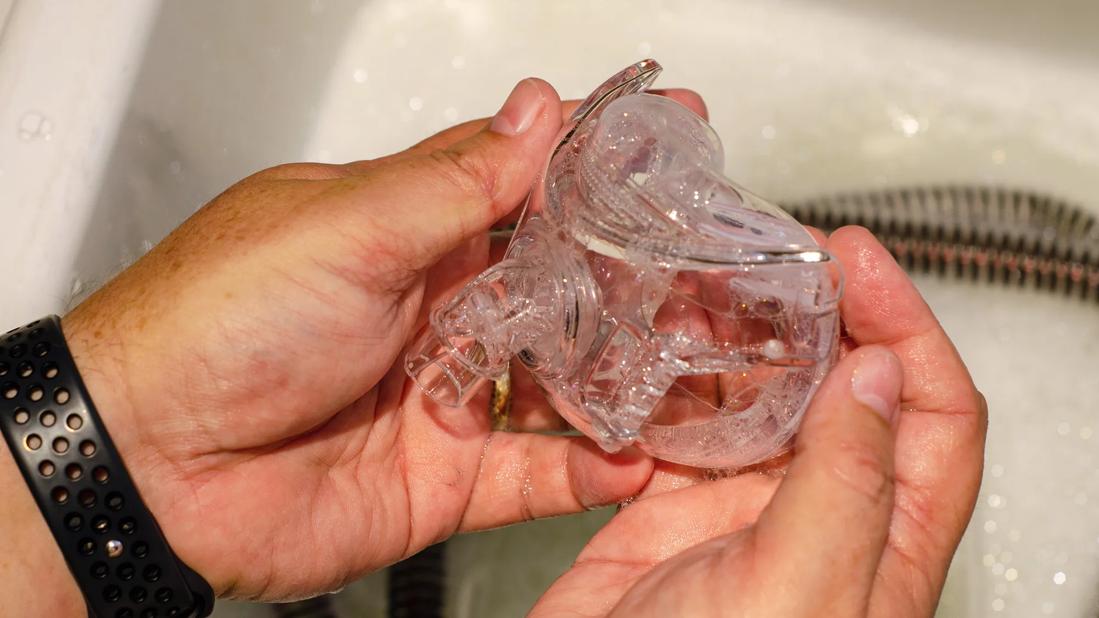A clean CPAP machine can help you sleep and breathe better

It may seem a daunting task, but CPAP machines work best when you clean them regularly.
Advertisement
Cleveland Clinic is a non-profit academic medical center. Advertising on our site helps support our mission. We do not endorse non-Cleveland Clinic products or services. Policy
Fortunately, it isn’t complicated or time-intensive to clean a CPAP. Continuous positive airway pressure (CPAP) machines have several parts that disconnect.
“Most cleaning steps take less than a few minutes,” says certified nurse practitioner and sleep medicine specialist Jennifer Brubaker, PhD, APRN-CNP.
And because the mask is directly in contact with your skin, it’s important to ensure that it’s clean and free of germs that may cause skin irritation or infection.
For example, the mask and headgear (straps) of a CPAP machine rest on your face, potentially trapping oil, dirt and germs. “You may develop acne or skin irritation if the mask or straps aren’t clean,” notes Dr. Brubaker.
Oil and dirt can also cause the straps to lose elasticity or prevent the fasteners from closing tightly. “You won’t get the full benefits of positive airway pressure if the mask doesn’t seal properly,” adds Dr. Brubaker.
Different companies make CPAP machines. These tips from Brubaker should work for most machines. But you should always read the manufacturer’s cleaning instructions that come with your device. “Using the wrong cleaning solutions or methods may void the warranty or affect how well the machine functions or lasts,” warns Dr. Brubaker.
Advertisement
Before you get started, make sure you have the following handy:
Some CPAP components, like the mask that directly makes contact with your skin, require daily cleaning. Others can be cleaned less often. And you may want to clean certain parts more frequently if you’re sick with a cold or COVID-19.
| CPAP component | Frequency |
|---|---|
| Mask | Daily |
| Headgear | Daily (if part of the mask) or weekly |
| Tubing | Weekly |
| Humidifier tub or water chamber | Weekly |
| Reusable filter | Weekly |
| CPAP machine exterior | Weekly |
| CPAP component | |
| Mask | |
| Frequency | |
| Daily | |
| Headgear | |
| Frequency | |
| Daily (if part of the mask) or weekly | |
| Tubing | |
| Frequency | |
| Weekly | |
| Humidifier tub or water chamber | |
| Frequency | |
| Weekly | |
| Reusable filter | |
| Frequency | |
| Weekly | |
| CPAP machine exterior | |
| Frequency | |
| Weekly |
When cleaning any part of your CPAP machine, make sure it’s unplugged from a power source and that you disconnect and separate the parts you’re cleaning from the ones you’re not.
Advertisement
You should never use CPAP cleaning machines because there’s no evidence that the machines are safe or effective. They also haven’t been approved by the U.S. Food and Drug Administration (FDA) for routine CPAP cleanings.
In fact, the FDA cautions that CPAP cleaning machines may:
You can also skip commercial CPAP cleaners like mask wipes. “There’s no reason to spend money on unproven devices or wipes when soap and water work well, and the cleaning process is so easy,” says Dr. Brubaker.
Other products you should avoid that could damage your CPAP machine or leave residue that may affect your breathing include:
It isn’t complicated and doesn’t take long to clean the parts of your CPAP machine — and your face and lungs will thank you for the regular maintenance and upkeep.
“I encourage people to make mask-cleaning part of their morning routine, similar to brushing your teeth or washing your face after you wake up,” recommends Dr. Brubaker.
Advertisement
Advertisement
Learn more about our editorial process.
Advertisement

It’s OK if congestion forces you to take a break from using this breathing device

Tart cherry juice contains natural compounds that may support better sleep

Diaphragmatic breathing, pursed lip breathing and huff coughing can help manage COPD symptoms, like chest congestion and shortness of breath

If you’re waking up drenched, it could be menopause, stress, medications and other causes

Stick to a consistent schedule, be mindful of screen time and work on reducing your stress levels before bed

Masking can help reduce the spread of respiratory illnesses in certain situations

Managing stress can help you sleep more soundly

Napping can boost focus, memory and mood — if you time it right

Babies can get congested easily, but you can calm their cough by keeping them hydrated, using nasal drops and running a humidifier

Weight loss may cause loose, sagging skin and muscle loss to your rear

Several conditions, like vitiligo and fungal infection, can cause a loss of pigmentation, leading to white spots or patches on your skin